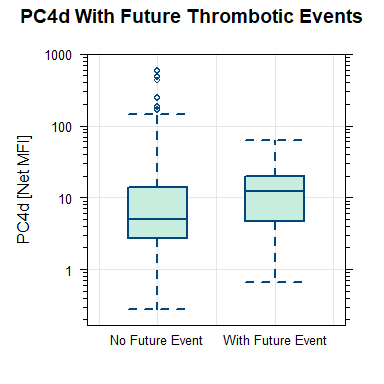Session Information
Date: Sunday, November 13, 2022
Title: SLE – Diagnosis, Manifestations, and Outcomes Poster II: Manifestations
Session Type: Poster Session C
Session Time: 1:00PM-3:00PM
Background/Purpose: Platelet-bound complement activation products (PC4d) are associated with a history of thrombosis in systemic lupus erythematosus (SLE) (Gartshteyn al., 2021; Petri et al., 2017). The current study evaluated the role of PC4d in assessing the risk of future thrombosis.
Methods: PC4d (expressed at net mean fluorescence intensity [MFI]) was measured by flow cytometry from patients enrolled in the Lupus Cohorts at Columbia Univ (COL), Johns Hopkins Univ (JH) and Beth Israel Deaconess Medical Center (BI) between Apr-Sep 2017 (JH), Aug 2018-Jan 2020 (COL), and Oct 2018-Mar 2022 (BI). History of thrombotic vascular events was confirmed by medical record review. Data were analyzed by chi-square and logistic regression. Diagnostic odds ratio (DOR) was calculated. If a patient had 2 arterial or 2 venous events, only the closest in time to PC4d measurement was included in the analysis.
Results: A total of 419 SLE patients were enrolled. Main demographic and clinical characteristics are in Table 1. Seventy-four thrombotic events occurred in the 5 years pre- to 3 years post-PC4d measurement. Of these 74, 50% had PC4d≥10 MFI at enrollment while 72% of patients without thrombosis had PC4d< 10 (p< 0.001). 19 events occurred in 15 subjects in the 3 years after PC4d measurement: 8 cerebrovascular accidents, 3 deep vein thrombosis, 2 gastrointestinal infarctions, 2 myocardial infarctions, 1 pulmonary infarction, 1 arterial thrombosis and 2 venous thrombosis not specified. Median PC4d was higher in the 15 patients with than in the 404 patients without thrombosis (12.2 MFI, IQR: 4.7-19.6 vs. 4.9 MFI, IQR: 2.6-13.6, p=NS) (Figure 1). When the arterial events closest to PC4d measurements (8 of 14 total arterial events) were included, PC4d >13 MFI had sensitivity=62%, specificity=74%, DOR=4.8 (95%CI: 1.1, 20.3), p=0.034 in predicting future arterial thrombosis in patients with a previous arterial thrombosis. As expected, a previous arterial thrombosis was a strong predictor of a subsequent arterial event (p=0.0042). PC4d≥10 or ≥20 MFI did not reach statistical significance for future thrombosis neither in the entire population (p=0.055 and 0.51, respectively) nor in the subgroup younger than 65 years old (p = 0.99 for both). However, the negative predictive value of PC4d< 10 MFI was 98%, indicating that probability of not having a thrombosis within 3 years is 98% if PC4d< 10 MFI. Of the 285 patients with PC4d< 10 MFI, 105 (37%) were positive for at least 1 of 8 anti-phospholipid antibodies (aPL) (3 aCL, 3 anti-B2GP1, or 2 anti-PS/PT antibodies), and 22 (7.8%) were positive for 3 aPL, indicating that the probability of not having a thrombosis if PC4d< 10 MFI holds true for the population aPL positive and presumed at higher risk.
Conclusion: PC4d≥10 MFI is associated with thrombosis in SLE and predicts future arterial thrombosis (DOR=4.8), despite the small number of events post-PC4d. Interestingly, patients with PC4d < 10 MFI have a 98% probability of not experiencing a thrombotic event in the following 3 years. Taken together, these findings suggest that PC4d levels help evaluate the risk of thrombosis in SLE and can guide the decision to start low dose aspirin.
Data is reported as number (n) and percentages (%). Anti-phospholipid (aPL) positivity was based on positivity for any of the isotypes: anti-phosphatidylserine/prothrombin complex (PS/PT) IgG or IgM, anti-cardiolipin (aCL) IgG, IgM, or IgA, and anti-beta2-glycoprotein1 (aB2GP1) IgG, IgM, or IgA.
To cite this abstract in AMA style:
Askanase A, Conklin J, Petri M, Kyttaris V, Gartshteyn Y, Tang W, Kammesheidt A, Alexander R. Role of Platelet-bound Complement Activation Product (PC4d) in Predicting Risk of Future Thrombotic Events in Systemic Lupus Erythematosus [abstract]. Arthritis Rheumatol. 2022; 74 (suppl 9). https://acrabstracts.org/abstract/role-of-platelet-bound-complement-activation-product-pc4d-in-predicting-risk-of-future-thrombotic-events-in-systemic-lupus-erythematosus/. Accessed .« Back to ACR Convergence 2022
ACR Meeting Abstracts - https://acrabstracts.org/abstract/role-of-platelet-bound-complement-activation-product-pc4d-in-predicting-risk-of-future-thrombotic-events-in-systemic-lupus-erythematosus/


